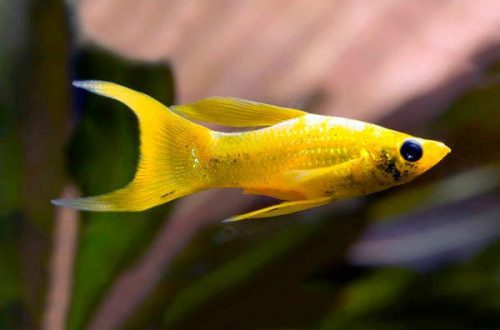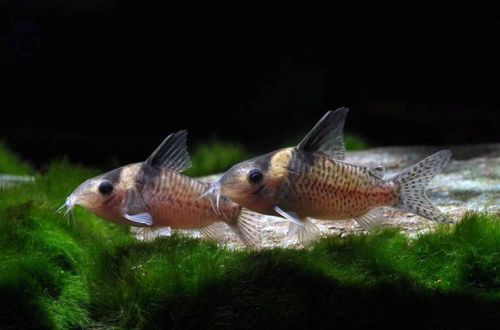
Apistogram Kellery
Apistogramma Kellery, scientific name Apistogramma bitaeniata, belongs to the Cichlidae family. Previously considered an unidentified species under the name Apistogramma sp. Kelleri. The fish went on sale in 2008. Exporters often refer to it as Apistogram Laetitia, so this name can be considered equivalent. Easy to keep, compatible with other non-aggressive species. It is distinguished by unusual behavior during spawning and caring for offspring, which is not characteristic of most representatives of this genus of American cichlids.

Contents
Habitat
It comes from South America from a section of the Amazon called Solimões, located at the point where the borders of Colombia, Peru and Brazil meet. The fish inhabits small rivers and streams flowing under the canopy of the rainforest. The typical habitat is a small forest stream with a depth of no more than 1 meter with clear water, the bottom of white sand is covered with a layer of fallen leaves. Aquatic plants are absent.
Brief information:
- The volume of the aquarium – from 50 liters.
- Temperature – 22-29°C
- Value pH — 4.0–6.0
- Water hardness – 0–5 dGH
- Substrate type – sandy
- Lighting – subdued
- Brackish water – no
- Water movement – light or moderate
- The size of the fish is 6–8 cm.
- Food – any food
- Temperament – conditionally peaceful, males are territorial during spawning
- Content alone, in pairs or in a group
Description

Adult males reach a length of about 8 cm. They have elongated and pointed fins. The color is silvery with a blue tint. During the spawning period, red pigmentation appears on the head. Females are slightly smaller – up to 6 cm. The fins are shorter, and the color is predominantly pale yellow. A characteristic feature is a black diagonal stripe on the head.
Food
Refers to carnivorous species. In nature, the basis of the diet are small invertebrates. In a home aquarium, it is able to adapt to dry food in the form of flakes, granules. It is recommended to serve live or frozen brine shrimp, daphnia, bloodworms.
Maintenance and care, arrangement of the aquarium
The optimal sizes for one or two fish start at 50 liters. Not pretentious in terms of design. Nevertheless, they will look more harmonious in an environment that resembles a natural habitat. The main elements of the decor will be sandy soil and a few snags. The lighting is subdued. The presence of aquatic plants is not required. If breeding is planned, then several shelters will need to be provided. These can be decorative caves, grottoes, or ordinary ceramic pots turned over on their side, or pieces of PVC pipes.
An additional design element will be dried leaves at the bottom of the aquarium, which, among other things, saturate the water with tannins, as happens in natural reservoirs. Read more about this in the article “Which tree leaves can be used in an aquarium.”
The long-term success of Kellery’s Apistogramma depends largely on maintaining stable water conditions. Sharp fluctuations in temperature, hydrochemical values (pH and dGH), as well as the accumulation of dangerous concentrations of nitrogen cycle products (ammonia, nitrites, nitrates) should not be allowed. To achieve this goal, the aquarium is equipped with the necessary equipment and regular maintenance is carried out. The latter includes at least a weekly replacement of part of the water with fresh water and the timely removal of organic waste (feed leftovers, excrement).
Behavior and Compatibility
Unlike other Apistograms, he has a relatively calm disposition towards relatives. In a small aquarium, it is desirable to keep one by one. In the presence of large volumes, a flock of these fish is able to peacefully coexist with representatives of other species.
Breeding / breeding
In favorable conditions, the appearance of fry is very likely even in an amateur aquarium. Apistogramma Kellery is the only member of the genus that keeps fertilized eggs in its mouth during the incubation period. However, such a strategy for protecting future offspring does not always manifest itself. Sometimes fish form a clutch in a hole dug in the ground. In addition, both parents can be involved in the care of eggs and fry. It has been noticed that if the current in the aquarium is weak, then the female takes care of it, and if it is strong, then the male.
Fish diseases
The main cause of diseases lies in the conditions of detention, if they go beyond the permissible range, then immunity suppression inevitably occurs and the fish becomes susceptible to various infections that are inevitably present in the environment. If the first suspicions arise that the fish is sick, the first step is to check the water parameters and the presence of dangerous concentrations of nitrogen cycle products. Restoration of normal/suitable conditions often promotes healing. However, in some cases, medical treatment is indispensable. Read more about symptoms and treatments in the Aquarium Fish Diseases section.





